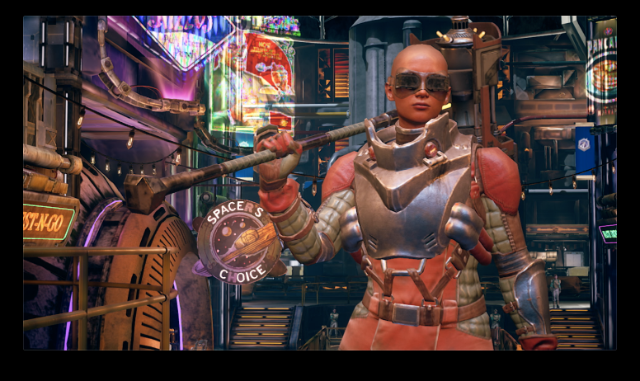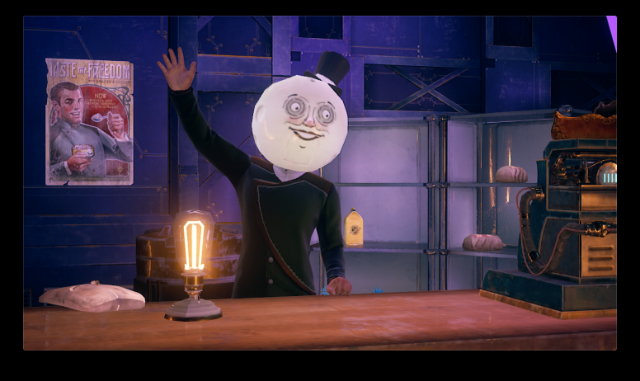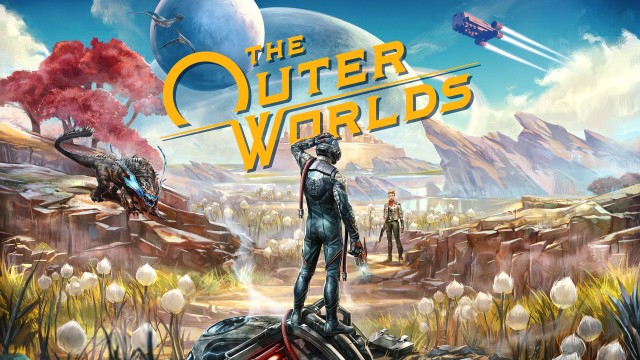In the dystopian landscape of The Outer Worlds, the galaxy has been colonized by corporations that underpay workers in hazardous conditions and sell their otherworldly goods and services at marked-up prices to the starved populous.
Among the least reputable of these morally bankrupt companies is Spacer’s Choice, famous for its blatantly inferior craftsmanship. In the real landscape of video game platforms, the Switch version of The Outer Worlds is the Spacer’s Choice version of the game. It’s immediately recognizable as the lesser version.
But if it’s your only way to play the RPG, or if you want to make it portable, some technical deficiencies don’t derail one of 2019’s best games from being one of 2020’s most exciting Switch ports.
The Outer Worlds Switch Review: Spacer’s Choice

The Outer Worlds is a first-person RPG from Obsidian Entertainment, which immediately excites a certain number of people. It’s new to Switch as of this week and brings a somewhat revised version of itself to the platform, but let’s start with what’s the same.
The Outer Worlds has an abundance to say, and it uses biting satire to tell a lot of it. Every poster is a takedown of an economy based on corporate greed, and most characters are either the players or being played. Despite that line in the sand, The Outer Worlds‘ greatest feat is how it builds real characters into its plot at every opportunity.
There are NPCs with whom you cannot interact, but the number of characters who are quest givers with fleshed-out stories and opinions is remarkable. TOW was once billed as a Fallout Lite experience, but in few ways does it feel lacking compared to something like New Vegas, which the team at Obsidian made during the last generation.
In fact, it’s often an improvement on the team’s fan-favorite RPG. The Outer Worlds is brimming with reasons to stay in its world. Even your silent protagonist has a bevy of personalities to choose from, including a unique idiot mode where you can respond like a fool if your intelligence is low enough.
It’s a constant joy to find new people to meet, learn their stories, and aid them in their quests. While some missions do use tropes of the genre, the major story beats are nuanced and praiseworthy. More than once, I put the controller down to weigh the pros and cons of a decision I was about to make.

You’d think a world where people are either the exploiters or the exploited would fall victim to a binary hero and villain system. Still, the story of The Outer Worlds unfurls with the understanding that life is rarely so black and white, even in a world where a mysterious plague wiping out a settlement is just malnourishment.
Among the many characters you meet are a half-dozen companion characters. In that way, The Outer Worlds moves closer to a Mass Effect system — it allows you to bring characters aboard your ship and take up to two of them with you on missions. You can mix and match pairings, stick with favorites, or even go solo, and the game smoothly adapts to your decisions in ways both big and small. These companions each feel unique and worth getting to know, and you do so by completing their loyalty missions (sounds familiar, yes?).
It’s this wrinkle that keeps The Outer Worlds from being just another New Vegas, even as so much else, from skill trees to its sense of humor, feels much like Obsidian’s previous mega-hit.
The story was also said to be briefer than games like it, but my first playthrough still took me 40 hours, and I didn’t see everything there was to see. I don’t mean simple collectibles, either. I missed entire questlines too.
TOW is not a bite-sized RPG, though, with the smart use of hub worlds, it doesn’t feel bloated either. It’s great to arrive on a planet, do everything you can there, meet tons of interesting characters, loot and shoot, and then depart for the next locale.
Some backtracking is involved, but the quest log is designed so intuitively that you won’t have to do any extra work to streamline your progress. It breaks missions down in a variety of categories so you know what’s major and minor and where everything can be completed. It’s satisfying, and it makes the game markedly better.

Exploration is lacking a greater sense of discovery. While locations are varied and characters are interesting, it’s rarer to stumble upon a story in The Outer Worlds that’s understated. It feels as though every interesting thread you can pull comes with cutscenes or long dialog options. In a game like this, though, the stuff that sticks with you is often what’s pieced together through seemingly unrelated text or audio logs.
I do not doubt that The Outer Worlds will receive sequels for years to come, and I should hope the next game improves this facet.
Combat will feel familiar for Fallout veterans, meaning it’s serviceable but not great. On Switch, The Outer Worlds seems to have been given a new aim assist feature that I did not find present upon revisiting my Xbox version. It’s good that it’s available for Switch too, as the smaller screen in handheld mode and poor control sticks make shooters less fun on the platform. Luckily, The Outer Worlds smartly compensates for these baked-in problems.
That’s not the only thing different on Switch, but it’s the last good thing that’s unique to this version of the game. It’s apparent early and often that this game would’ve had trouble on the platform if it weren’t for several concessions. Chiefly, these consist of consistently inferior textures, lighting, and colors, as well as longer load times.
Stacking up my Xbox One S playthrough with my Switch playthrough, the latter’s visuals are blatantly worse and, at times, even designed differently. Skyboxes are less colorful, and architecture is less intricate. Some trees and other environment pieces are absent, and locale transitions that take 25-30 seconds to load on Xbox regularly take more than 40 seconds on Switch.
Lighting effects sometimes appear to be painted across the distance in real-time, and textures pop in but never look great — even when you’re right up next to them.
Here are some screenshots for comparison.
Xbox One S
Switch
Xbox One S
Switch
Switch
All of this is to say it’s clear that The Outer Worlds on Switch was too ambitious in its original state, so the game was visually watered-down to get it to work on the system.
Ironically, after infusing its latest RPG with much more color than the drab Fallout New Vegas, The Outer Worlds on Switch ends up looking quite dreary itself, which isn’t out of place in such a dystopia. Still, since the world is always presented with tongue firmly in cheek, the colors make more sense for the world and are thus disappointingly absent on Switch.
For what it’s worth, though, I saw no slowdowns or frame rate drops, so if the visuals take a hit in favor of stability, I think that’s a reasonable tradeoff.
The Outer Worlds Switch Review — The Bottom Line
Pros
- Dynamic characters at every turn
- Quests and choices that deliver awesome, memorable moments
- Witty, satirical writing
- Aim assist is added to aid Switch version
- Smart quest log UI that all RPGs should follow
Cons
- Clear visual downgrades on Switch
- Longer load times on Switch
- Lacking player-driven stories
Some of The Outer Worlds’ best and worst qualities on Switch are symptoms directly related to the platform. Making a major RPG portable is as cool here as it was with The Witcher 3, though the technical and visual downgrades are more apparent here than they are there.
Still, with extremely well-written characters, great quests that keep you busy for 40+ hours, and some smart adjustments for this platform specifically, The Outer Worlds remains a can’t-miss experience. If you can play it elsewhere, you should, but if Switch is all you have or all you want, the pictures aren’t as pretty, but everything else still shines.
The Outer Worlds is still one of the most binge-worthy RPGs of the generation.
[Note: A copy of The Outer Worlds on Nintendo Switch was provided by Private Division for the purpose of this review.]







Published: Jun 4, 2020 01:12 am